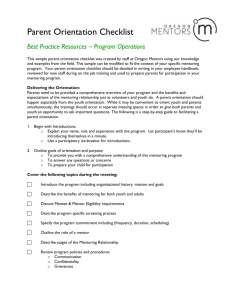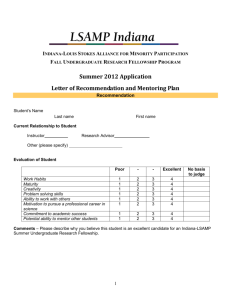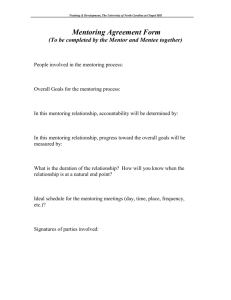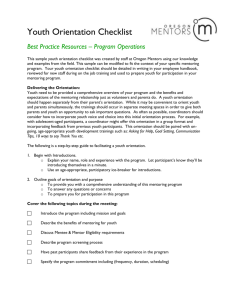Spring 2016 Co-Teaching Power Point
advertisement
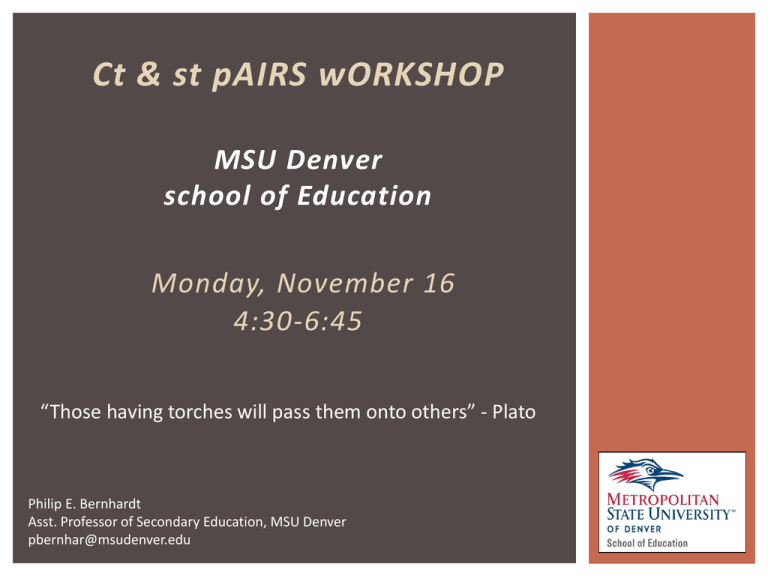
Ct & st pAIRS wORKSHOP MSU Denver school of Education Monday, November 16 4:30-6:45 “Those having torches will pass them onto others” - Plato Philip E. Bernhardt Asst. Professor of Secondary Education, MSU Denver pbernhar@msudenver.edu BEGINNING TEACHERS Beginning teachers can only reasonably be expected to succeed if they receive intentional, comprehensive support catered to meet their unique needs. WORKING DEFINITION OF MENTORING Professional practice that occurs in the context of teaching whenever an experienced teacher supports, challenges, and guides [pre-service] or novice teachers in their teaching practice. Odell and Huling (2000, p. xv). Qualit y Mentoring for Novice Teachers SIGNIFICANCE OF COOPERATING TEACHERS ① Effective CTs are critical to clinical experiences. ② Student teachers view student teaching as the most important component in their preparation and consider their CT as essential to their success. ③ Wide acceptance: “cooperating teachers are the most powerful influence on the quality of student teaching and shape what student teachers learn by the way they mentor” (Weiss & Weiss, 2001) 11 WAYS COOPERATING TEACHERS PARTICIPATE IN TEACHER PREPARATION • Providers of feedback • Conveners of relation • Gatekeepers of the • Agents of socialization profession • Modelers of practice • Supporters of reflection • Advocates of the practical • Abiders of change • Teachers of children • Gleaners of knowledge • Purveyors of context Brodie, Cowling, Nissen, (2009), Understanding participation: A literature review DEVELOPING PROFESSIONAL RELATIONSHIPS ① What are the likely ACTIONS of an effective cooperating teacher? ① What do these ACTIONS look like in practice? QUALITIES: HIGH-PERFORMANCE MENTOR TEACHER Rowley, J. (2009) The High Performance Mentor EFFECTIVE MENTOR TRAITS (JOHNSON, 2008) ① Sensitive to the needs of beginning teachers. ② Ability to listen (inviting discussion & sharing). ③ Communicate openly (including sharing own struggles). ④ Understanding of diverse learning preferences & past experiences. ⑤ Restraint from judgment (use data as part of reflection). ⑥ Models continuous learning. ⑦ Shares understanding of state/national standards as well as district/school expectations and norms. EFFECTIVE MENTORING: 4 DOMAINS OF SUPPORT Physical · · Help arrange, organize, and decorate the classroom. Give a tour of the building. Emotional · Engage in active and supportive listening. · Establish a common language of instruction. · Conduct daily check-ins. · Use a scale/tool to measure progress. Validate the teacher’s feelings. · Describe an average day at school. · · Explain administrative procedures. · · Help prepare for 1st day of school. · · Demonstrate how to use school technology tools. · Celebrate success. · Explain the procedure for substitute plans. · · Identify and help prepare for students with special needs. Establish consistent times and means to communicate with one another. · Explain the district’s teacher evaluation system. · Help initiate communication with parents. Instructional Send encouraging messages. Enlist support from other teachers, administrators, and staff members. Institutional · Explain the school culture. · Help establish a support network. · Provide further details and support around teacher evaluation process. · Establish collaboration time with appropriate colleagues. · Help set appropriate growth goals. · Mentor up the scale. · Give focused feedback. · Share educational research. · Analyze data and guide reflection. · Help secure membership in educational organizations. · Provide opportunities to observe and discuss effective teaching. · Facilitate involvement in extracurricular activities. · Foster relationships with coworkers. Source: Supporting Beginning Teachers Webinar (http://www.marzanoresearch.com/resources/webinars) INSTRUCTIONAL MENTORING High Leverage Teaching Practices http://www.teachingworks.org/work-ofteaching/high-leverage-practices (Included in Workshop Handouts) Renewed Planning: Participants determine next steps and cycle repeats with next observation. Conferencing to Review Classroom Events: CT (and possibly university supervisor participate. Planning for the Conference: Both CT and and student teacher develop general plans to discuss outcomes, classroom management, and the teaching/learning process; follow-up may be strategies outlined. Establishing a “helping trusting” relationship. Becoming acquainted, establishing roles and expectations, discussing learning styles, reviewing preferred ways of communicating, and clarifying how clinical supervision is implemented. A Collaborative Clinical Supervisory Approach Analyzing Data for Important Patterns in the Teaching Process: CT and student teacher independently analyze the instruction. Planning Lessons and Units with the Teacher: Plans would include clear objectives, anticipated problems, special learning circumstances, and strategies for teaching the lesson or unit. Planning for the Observation: CT and student teacher discuss what will be observed during the lesson and how data will be collected. Observing Instruction: CT watches the lesson and records data on classroom events. COLLABORATIVE CLINICAL MENTORING MODEL Establish: Co-planning time. Observation routine. Conferencing opportunities to provide feedback and engage in a process of continuous improvement. To consider, for example: When will we schedule? What times of day are available? How can we make it consistent? Can we implement each step of the process? What will this look like? Challenges? POST-OBSERVATION CONFERENCING: EFFECTIVE FEEDBACK ① Effective feedback is timely, directs attention to intended learning, and offers specific details. ② Describe observations rather judge. ③ Occurs during the learning process, when one can act. ④ Effective feedback does not “do the thinking. Discuss alternatives and ask questions rather giving solutions . ⑤ Effective feedback limits the corrective information to an amount a receiver can practically process/implement. ⑥ Feedback should lead to action. CO TEACHING STRATEGIES 1. One Teach: One Observe 2. One Teach: One Assist 3. Station Teaching 4. Parallel Teaching 5. Supplemental Teaching 6. Alternative (Differentiated) Teaching 7. Team Teaching WORKING DEFINITION OF MENTORING Professional practice that occurs in the context of teaching whenever an experienced teacher supports, challenges, and guides [pre-service] or novice teachers in their teaching practice. Odell and Huling (2000, p. xv). Qualit y Mentoring for Novice Teachers REFERENCES Brodie, E., Cowling, E., & Nissen, N. (2009). Understanding participation: A literature review . London, England: NCVO, IVR & Involve. Johnson, K. (2008). Being an effective mentor: How to help beginning teachers succeed. Thousand Oak, CA: Corwin. Odell and Huling (2000).Quality Mentoring for Novice Teachers. Joint publication: Washington, D.C.: Association of Teacher Educators and Indianapolis, Indiana: Kappa Delta Pi. Rowley, J. (2009) The High Performance Mentor. Thousand Oaks, CA: Corwin. Weiss, E. M., & Weiss, S. (2001). Doing reflective supervision with student teachers in a professional development school culture. Reflective Practice, 2, 125 –154.



